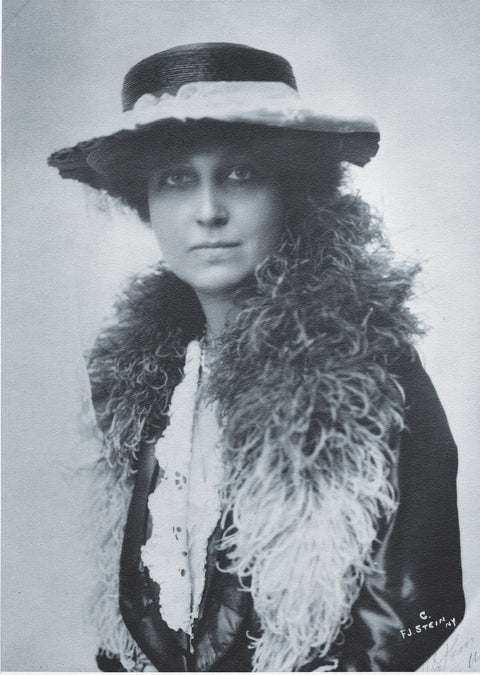
Meet the Smuggler Who Brought Birth Control to the US
Through the 1920s, Katharine Dexter McCormick periodically sailed from Europe to New York with garment-stuffed trunks. Had U.S. Customs Service inspectors checked—they did not—they might have thought McCormick a clotheshorse. What McCormick was was a smuggler—of birth control devices. Sewn into her wardrobe were diaphragms, long available in Europe but since 1873 banned in the United States.
Posing as a scientist, McCormick met with diaphragm makers, bought products, and sneaked them to Brooklyn family planning advocate Margaret Sanger. McCormick’s dedication to women’s well-being led to one of the 20th century’s most consequential inventions: the birth control pill.
McCormick grew up with activism. Her grandfather, Samuel Dexter, who made his money in land speculation, founded Dexter, a town in southeast Michigan, and maintained an Underground Railroad stop in his grand home. Father Wirt Dexter, a wealthy Chicago lawyer, led that city’s Relief and Aid Society, and mother Josephine fought for female suffrage. Their second child, Katharine, born in 1875, would embrace causes of her own. And she would employ science to make the case for those causes.
McCormick, left, killed an MIT rule requiring female
students to wear hats in lab by noting that feathers are flammable. (MIT
Museum)
Katharine was 14 when Wirt Dexter died of a stroke and 18 when meningitis claimed her brother, Samuel. Those premature deaths likely piqued her interest in medicine.
Josephine and Katharine relocated to Boston, where Katharine became the second woman to graduate from Massachusetts Institute of Technology and the first to earn a degree in biology there. As an undergraduate, she fought a rule requiring female students to wear hats in the laboratory. Arguing that the plumes then fashionable were flammable, McCormick won.
Graduating in 1904, she wed Stanley McCormick, an heir to the International Harvester farm machinery empire founded by his father, Cyrus. Stanley and Katharine would remain wed for 40 years, but by 1906 doctors were hospitalizing him for dementia praecox, as schizophrenia was then known. Katharine became Stanley’s medical advocate, battling his siblings and his doctors to recognize the biology that underlay her husband’s mental symptoms—a fight that novelist T. Coraghessan Boyle rendered fictionally in his 1998 novel Riven Rock.
Besides McCormick resources, Katharine had her own money. Upon her mother’s death in 1937, she inherited $10 million.
Stanley never recovered. Along with representing her husband’s interests, his wife took up the intertwined issues of women’s suffrage and reproductive rights.
McCormick dedicates an MIT
dorm named for her spouse. (MIT Museum)
In 1909, Katharine spoke at a suffrage demonstration in Massachusetts. Later she served as lieutenant, treasurer, and vice president of the National American Woman Suffrage Association, the group pushing for a constitutional amendment giving American women the vote.
Brooklyn-based activist Margaret Sanger was jailed in 1917 for running a family planning clinic. McCormick joined the Committee of 100—a group of wealthy benefactors devoted to Sanger’s cause.
“The clarion bell of her imprisonment awoke me, as it did others, into the definite realization of what must be done,” McCormick wrote later. “And with this realization came the awareness that a battle lay ahead.”
McCormick and Sanger became lifelong friends.
The 19th Amendment giving women the vote was ratified in 1920, but birth control remained outlawed—hence McCormick’s decade of diaphragm smuggling.
A 1960 package of birth control pills. (Photo by
SSPL/Getty Images)
During that period, McCormick also endowed the Neuroendocrine Research Foundation at Harvard Medical School, the first facility to explore the role played by hormones in mental illness. McCormick also believed that further research was needed to help women control the timing and frequency of pregnancies.
When Stanley McCormick died in 1947, McCormick, 72, inherited more than $35 million. Taxes took much of that, but she still could afford to fund the campaign of her dreams. Sanger’s family planning foundation was underwriting a small project using the costly hormone progesterone to halt ovulation in rabbits at the Worcester Foundation for Experimental Biology in Shrewsbury, Massachusetts. Reproductive biologist and in vitro fertilization pioneer Gregory Pincus was overseeing the rabbit study. McCormick, who was supporting schizophrenia research at that facility, suggested that she and Sanger meet with Pincus.
The day the three met in 1953, McCormick wrote a $20,000 check to launch a birth control pill project. In time, her support totaled $2 million. Thanks to her generosity and to breakthroughs in substitutes for natural progesterone, the project soon was delivering promising results. Clinical trials that began in 1956 led to U.S. Food and Drug Administration approval in 1960 of a prescription birth control pill.
One of McCormick’s last gestures came in 1959. MIT was resisting admitting more women, pleading lack of housing. With a pen and a checkbook, McCormick scratched out her alma mater’s excuse. Construction of Stanley A. McCormick Hall ushered in “an era in which the number of woman students steadily grew,” according to MIT.
Late in life, as a symbolic celebration, Katharine Dexter McCormick got a prescription for birth control pills and had it filled at a drug store. “She carried herself like a ramrod,” said Elizabeth Notkin, Gregory Pincus’s wife. “Little old woman she was not. She was a grenadier.” McCormick was 92 when she died in Boston in 1967.
